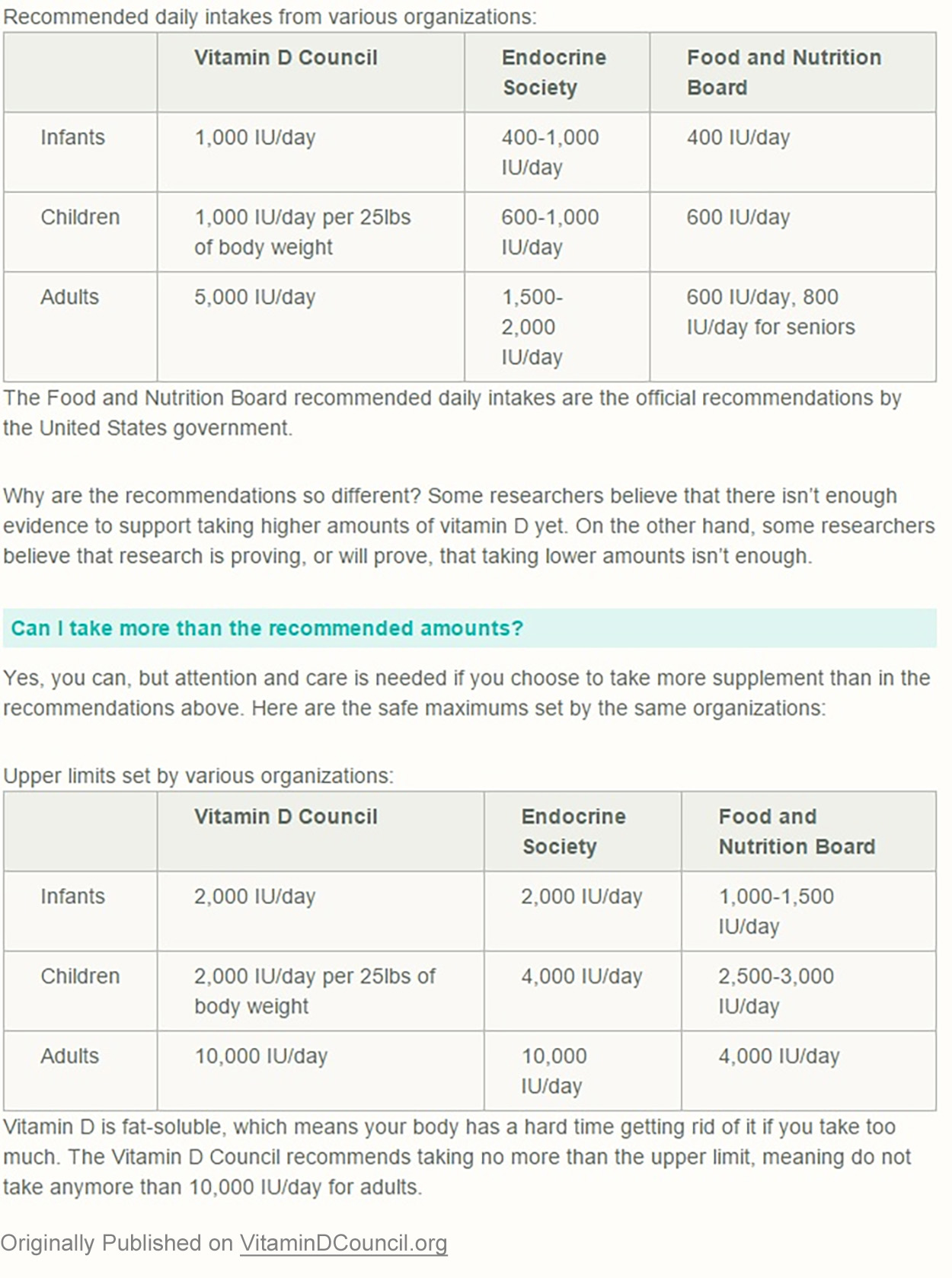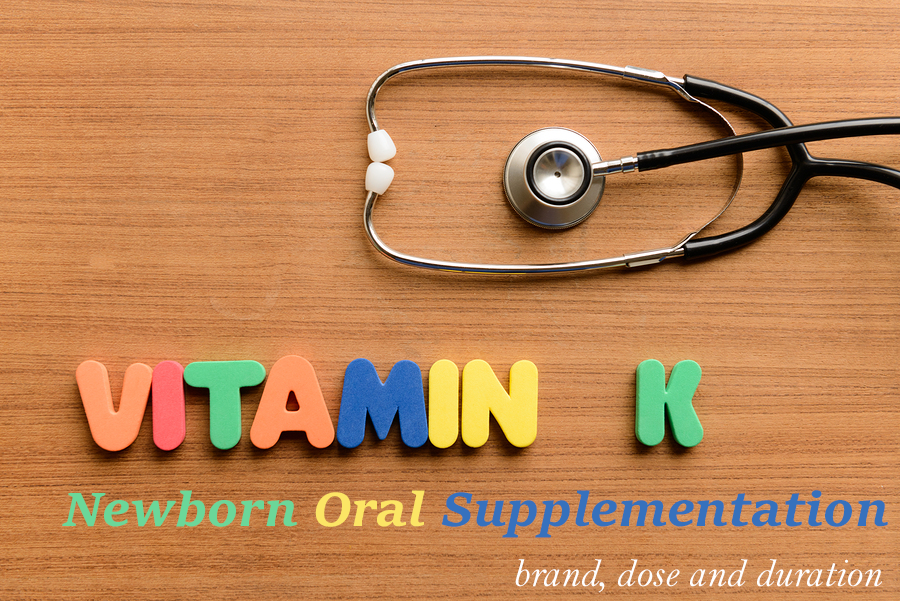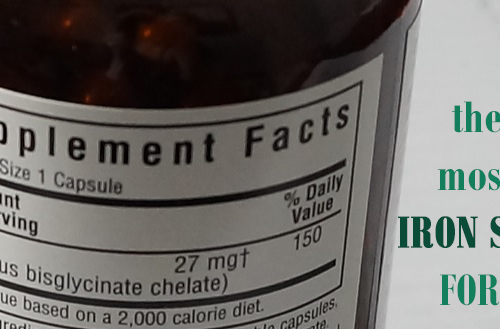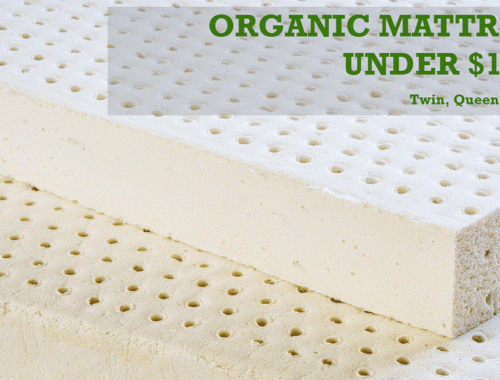The internet is full of articles, blogs, on vitamin K shot and why it may not be safe. Instead of re-iterating the same information over and over, I would like to focus on the newborn oral vitamin K dosage and supplementation.
If you are in the dark, start here and here. But just in-case:
Brief background
Vitamin K is a vitamin necessary for blood to clot and is essential in preventing vitamin K Deficiency Bleeding (VKDB). VKDB is rare but is life threatening.
There are three types:
- Early onset disease – onset within first 24 hours
- Maternal anti-sz meds that interfere with vitamin K metabolism (phenytoin, phenobarbital, carbamezepine, or primidone)
- Maternal anti-coagulants (coumadin, aspirin)
- Maternal antibiotics, especially cephalosporins
- Classic disease – onset between day 2 – 7
- Breastfeeding exclusively
- Late onset disease – onset between 2 weeks and 6 months
- Marginal levels of vitamin K in breast milk
- (Infant) Cystic fibrosis
- (Infant) Celiac disease
- (Infant) Chronic diarrhea
- (Infant) A1-antitrypsin deficiency
- (Infant) Hepatitis (source)
“Late-onset vitamin K deficiency bleeding tends to be more severe than early-onset or classic disease and has a high frequency of intracranial hemorrhage. Intracranial hemorrhage is observed in more than 50% of infants with late-onset disease.” (source)
The practice of administering vitamin K at birth has been around since 1944; the recommendation has not been changed since or even followed up on with any research. Use of foreceps and later a vacuum was common, the umbilical cord was cut immediately and breastfeeding was delayed.
- Delay cord clamping to provide baby with his/her nature intended blood that is rich with clotting factors
- Breastfeed soon after delivery so baby gets the vitamin K rich colostrum
“One of the most disturbing aspects of the vitamin K controversy is that there is little research to determine whether such high levels of vitamin K might be harmful to a newborn in some way. Research regarding vitamin K has only looked at the effect on HDN, the bleeding issue.” (source)
Options
Vitamin K intramuscular prophylaxis at birth (shot)
There are two brands.
Hospira.
Read about it here but it is not pretty. “Each milliliter contains phytonadione 2 or 10 mg, polyoxyethylated fatty acid derivative 70 mg, dextrose, hydrous 37.5 mg in water for injection; benzyl alcohol 9 mg added as preservative. May contain hydrochloric acid for pH adjustment.” And “Benzyl alcohol has been reported to be associated with a fatal “Gasping Syndrome” in premature infants.” Also, “Benzyl alcohol as a preservative in Bacteriostatic Sodium Chloride Injection has been associated with toxicity in newborns. Data are unavailable on the toxicity of other preservatives in this age group.” In addition to “WARNING: This product contains aluminum that may be toxic. Aluminum may reach toxic levels with prolonged parenteral administration if kidney function is impaired. Premature neonates are particularly at risk because their kidneys are immature, and they required large amounts of calcium and phosphate solutions, which contain aluminum. Research indicates that patients with impaired kidney function, including premature neonates, who receive parenteral levels of aluminum at greater than 4 to 5 mcg/kg/day accumulate aluminum at levels associated with central nervous system and bone toxicity. Tissue loading may occur at even lower rates of administration.” And finally, “Deaths have occurred after intravenous and intramuscular administration.“
Marcella Piper-Terry, M.S, long time vaccine safety advocate and founder of this website warns: “Hospira LOOKS like (from this photo) it contains 100 mcg of aluminum. It does not. The label reads “no more than 100 mcg of aluminum per LITER.” Each dose is .5mL (1/2 milliliter). There are 1,000 mL in 1 Liter. ALUMINUM is NOT the problem. The problem with Hospira is that it contains 9 mg. benzyl alcohol, which damages the liver and contributes to the high frequency of infants who develop jaundice within two days of birth. What IS VERY interesting about this is that the Hospira vial contains the information about aluminum at all. That’s because aluminum is limited in injectables to 5mcg/kg of body weight because at higher doses it causes kidney failure and brain damage. The information on the Vitamin K Injection is there because it is NOT a vaccine. Vaccines are somehow exempt from the rule about aluminum in other injectables. Here’s another interesting tidbit… At 100 mcg/L, you would have to inject TWO AND A HALF LITERS of the Hospira Vitamin K to reach the same level of aluminum that IS injected on the first day of life when an infant receives the Hepatitis B vaccine.”
Amphastar.
More here. “Each 0.5 mL contains 1 mg phytonadione (Vitamin K1 ), 10 mg polysorbate 80, 10.4 mg propylene glycol, 0.17 mg sodium acetate anhydrous, and 0.00002 mL glacial acetic acid. Additional glacial acetic acid or sodium acetate anhydrous may have been added to adjust pH to meet USP limits of 3.5 to 7.0.” Polysorbate 80 and Propylene Glycol are both neurotoxins. See for yourself: MSDS sheet for Polysorbate 80 and MSDS sheet for Propylene Glycol.
Very similarly to Hospira, Amphastar brand warns that “Severe hypersensitivity reactions, including anaphylactoid reactions and deaths have been reported following parenteral administration. The majority of these reported events occurred following intravenous administration… The possibility of allergic sensitivity, including an anaphylactoid reaction, should be kept in mind following parenteral administration…. Transient “flushing sensations” and “peculiar” sensations of taste have been observed, as well as rare instances of dizziness, rapid and weak pulse, profuse sweating, brief hypotension dyspnea and cyanosis… Pain, swelling, and tenderness at the injection site may occur… Infrequently, usually after repeated injection, erythematous, indurated, pruritic plaques have occurred; rarely, these have progressed to scleroderma-like lesions that have persisted for long periods. In other cases, these lesions have resembled erythema perstans… Hyperbilirubinemia has been observed in the newborn following administration of phytonadione. The has occurred rarely and primarily with doses above those recommended…”
Going back to Marcella Piper-Terry: “In January 2016, The American College of Pediatricians issued a statement indicating their concern about the amount of Polysorbate 80 in the HPV vaccine and the increased risk of infertility from premature ovarian failure (POF). Each dose of Gardasil contains 50 mcg. of Polysorbate 80. Amphastar Vitamin K injection contains 20 TIMES the amount of Polysorbate 80, when compared to Gardasil. What do you suppose that is doing to the future fertility of our children? Polysorbate 80 is also used in research to increase the permeability of the Blood Brain Barrier (BBB) – not a good thing when you are talking about babies whose BBB is already not completely impermeable… Here is the link to the press release about Polysorbate 80 and POF”
Lets note that the injection is 20,000 times greater than the levels at birth. It is recommended this massive dangerous dose is injected within an hour of birth. Injecting and ingesting are two very different processes with very different effects.
Oral prophylaxis
When I was pregnant with my daughter, I have already been through quite a few adventures with my son. I am not advocating going in ‘naked’ and not administering anything. The proponents of no supplementation do have a point tough. If every infant is deficient in vitamin K, does that mean nature made a mistake? I don’t know, as it rarely does… And the doctors dont know either.
Baby’s digestive system is not fully developed and the liver is not as functional. Excess vitamin K may not be a great idea. Interestingly, cord blood is full of stem cells that travel anywhere, including crossing the blood brain barrier to repair damage. By administering vitamin K (oral or intra muscular), these stem cells cannot move as freely and get to where they need to go and repair the damage. Read more here.
I however did not feel comfortable not giving anything and instead opted for oral vitamin K supplementation.
Lets talk dosage
These oral vitamin K doses were recommended most often:
- 1 mg oral vitamin K at birth, followed by daily doses of 25 mcg from 1 week to 3 months of age
- 1 mg oral vitamin K at birth, followed by 1 mg weekly oral doses to 3 months of age
Even Stanford has conflicting recommendation:
- 2 – 4mg PO vitamin K after first feeding then 2mg at 2 – 4 weeks and again at 6 – 8 weeks OR
- 2 – 4mg PO vitamin K after first feeding then 2mg within first week and weekly while breastfeeding OR
- 2mg PO vitamin K after first feeding then 2mg within first week followed by 25mcg daily for 13 weeks
So which is it?
When in doubt, ask pub med. Be sure to take these to the hospital in case anyone tries to pressure you into the shot.
My protocol is based on the following:
Infants with biliary atresia (rare liver disease) is the main argument against oral vitamin K vs injection; however there is research that includes newborns with biliary atresia. See this 2008 study. Vitamin K deficiency bleeding was noted in
- 25 of 30 of breastfed infants on 25 microg of daily oral prophylaxis (77.5%)
- 1 of 13 on 1 mg of weekly oral prophylaxis (7.2%)
- 1 of 10 receiving 2 mg of intramuscular prophylaxis at birth (9.3%)
- 1 of 98 formula-fed infants (P < .001)
It would seem that even if your baby has that rare condition, the oral vitamin K regimen is sufficient. In fact, it is more effective than the shot.
“A daily dose of 25 microg of vitamin K fails to prevent bleedings in apparently healthy infants with unrecognized cholestasis because of biliary atresia. One milligram of weekly oral prophylaxis offers significantly higher protection to these infants and is of similar efficacy as 2 mg of intramuscular prophylaxis at birth.” (here is that study again)
Another good study that looked at 507,850 babies. “Weekly oral vitamin K supplementation during the first 3 mo of life was an efficient prophylaxis against VKBD. Parental compliance with the regimen was good.”
Why I do not like the 25 micrograms daily, even for healthy infants:
- We don’t know which infant will have the rare liver condition and there is a dose that would cover such baby.
- This 2009 review… “If given orally, prophylaxis should be continued by either weekly administration of 1 mg untill 12 weeks or repeating 2 mg at weeks 1 and 4. Daily administration of 25 microg offers insufficient protection. The only infants not fully protected in this way are those with yet unrecognised liver disease.”
- And finally, the 25 mcg dose is precise and I am not aware of a supplement with this particular dose.
What I did and where to buy:
2mg at birth followed by 1mg weekly for 3 months (until age 13 weeks) based on the above mentioned, this study and this study and this study.
2mg at birth because that is the amount in the injectable form; followed up with 1mg weekly because that seems to be the optimal dosage recommendation even for babies with the rare liver condition.
Where to get the infant oral Vitamin K drops
This brand has the correct, easy dosage 2drops = 1mg
*4 drops = 2mg Please note, this is the only correct form of K – vitamin K1. “There were reports of hemolytic anemia and hyperbilirubinemia severe enough to cause kernicterus in the mid 1950s with high doses (50mg) of vitamin K2 (menadione). As a result, use of this form of vitamin K was abandoned. We now give infants vitamin K1 (phytonadione).” (source)
So… 4 drops within hours of birth, followed by 2 drops weekly until 13 weeks of age.
Don’t forget the vitamin D. I love this brand. Basic organic ingredients. We supplement 400 IU daily in the summer and up to 1,000 IU daily in the winter. Mayo Clinic says “If you’re breast-feeding or partially breast-feeding your baby, give your baby 400 international units (IU) of liquid vitamin D a day — starting in the first few days after birth.”
Slightly off topic but important… Recommended daily intakes from various organizations:

Final Notes
Whatever option you choose, some babies do not respond in the intended way.
If you are taking drugs that inhibit vitamin K, consider the vitamin K shot for your baby.
If a baby has a traumatic birth and experiences bruising or shows any clotting difficulties, then consider the vitamin K shot.
“There may be a very few babies with undiagnosed liver disease who would not be protected by a physiological birth and weekly oral vitamin K supplementation, so parents need to be vigilant for unusual signs of bruising or bleeding, regardless of whether the baby receives vitamin K supplementation. It is generally believed that a prompt response to these signs will prevent long-term problems for the baby.”
When the blood is drawn from the placental blood vessels after birth to check the baby’s blood type, ask the provider to observe the clotting. If the needle entry point seems to bleed more than usual, consider vitamin K shot.
Do not let your baby out of sight. Nurses are tired and overworked, sometimes they ‘forget’ and will administer whatever is routine. Ask to explain everything they will do before they touch your child.
Have a written natural birth plan. Check out my sample natural birth plan.
Consider a midwife instead of an obstetrician. Midwifes specialize in births; doctors specialize in critical births and labor situations such as C sections. Most likely you will not get your physician during your labor, rather whoever is on call from their practice anyway…
Delay cord clamping.
Consider forgoing circumcision. Many parents regret their decision. Current rates are 50% and it will be even less.
Say no to hepatitis B vaccine
- 60 Things that Can Go Terribly Wrong with Hepatitis B Vaccination
- Study Calls Into Question Effectiveness of Hepatitis B Vaccine for Newborns
Reconsider vaccines in general. Majority of the time the well read women who choose not to vaccinate do so AFTER a vaccine reaction. I was once a proponent of vaccines and vaccinating my son is one of my biggest regrets. There are hundreds of thousands of women like me.
- Dear Pregnant Mom who is just beginning to question vaccines
- Why I choose not to Vaccinate my child
- What is being injected into your child
- Vaccine package inserts. Read these to know exactly what is being injected you’re your infant
| Products mentioned in this article: |
|---|




